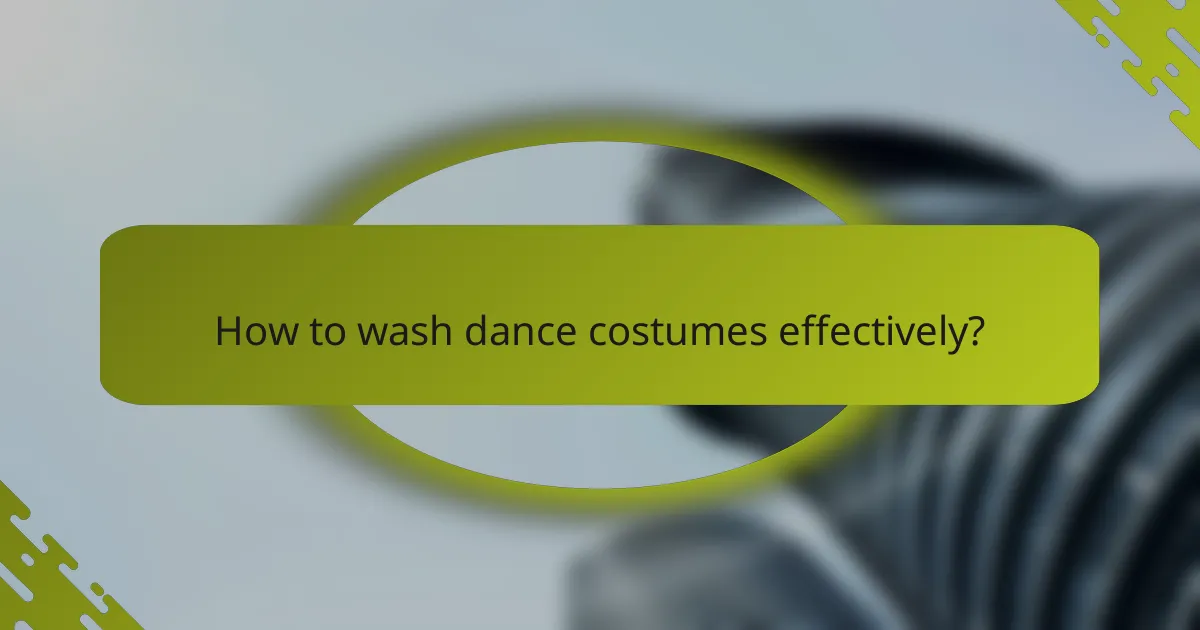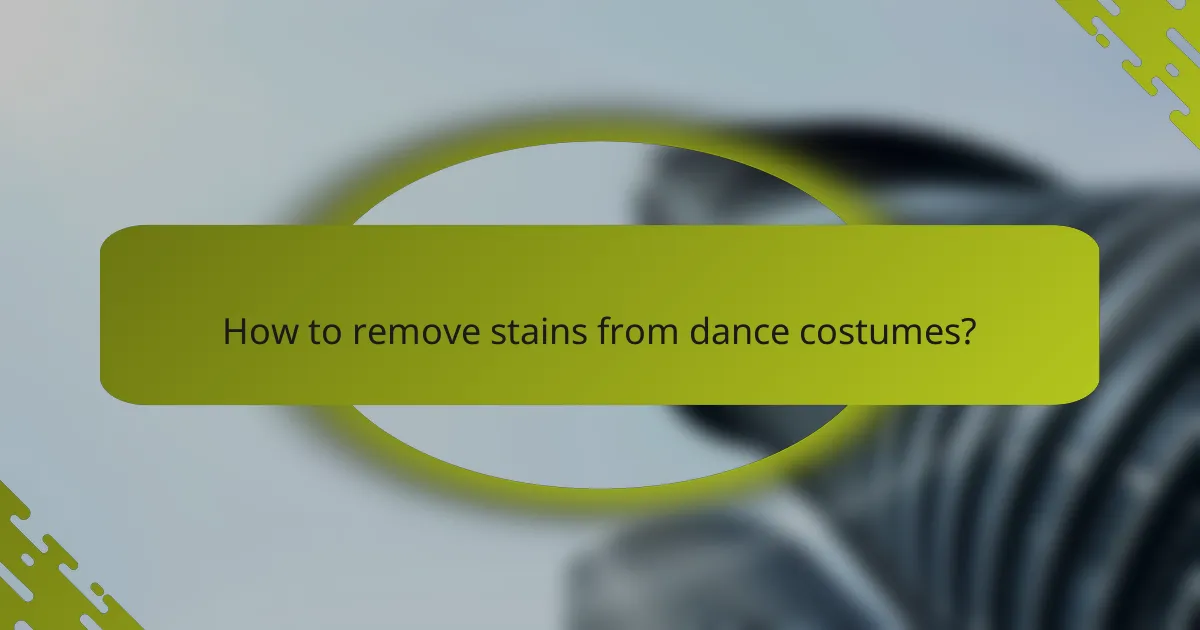Proper care and maintenance of dance costumes are essential for preserving their appearance and extending their lifespan. By understanding fabric types and following specific washing techniques, dancers can keep their costumes looking vibrant and fresh. Additionally, employing effective stain removal methods and practicing careful storage will ensure that these garments remain in top condition for every performance.

How to wash dance costumes effectively?
To wash dance costumes effectively, always prioritize the fabric type and follow specific care instructions. Using the right techniques will help maintain the costume’s appearance and longevity.
Use cold water for delicate fabrics
Cold water is essential for washing delicate dance costume fabrics, such as chiffon, tulle, and sequins. Hot water can cause shrinkage or damage, so always opt for a cold wash setting.
When washing in cold water, it’s advisable to soak the costume briefly before washing to help loosen dirt and sweat without harming the fibers.
Hand wash with mild detergent
Hand washing is the gentlest method for cleaning dance costumes, especially those made from sensitive materials. Use a mild detergent specifically formulated for delicate fabrics to avoid harsh chemicals that can degrade the costume.
Fill a basin with cold water, add the detergent, and gently agitate the water before submerging the costume. Allow it to soak for a few minutes, then gently rub any stained areas without scrubbing.
Utilize mesh laundry bags
If machine washing is necessary, always place dance costumes in mesh laundry bags to protect them from snagging or tangling. These bags allow water and detergent to circulate while keeping the costumes safe.
Choose a gentle cycle with cold water and avoid overloading the washing machine to ensure each costume has enough space to move freely.
Avoid bleach and fabric softeners
Bleach can irreversibly damage dance costumes, leading to discoloration or fabric breakdown. Always avoid using bleach, even in diluted forms, when cleaning.
Fabric softeners can leave residues that affect the fabric’s breathability and elasticity, so it’s best to skip them entirely. Instead, focus on using mild detergents that clean without adding unnecessary chemicals.

What are the best care methods for dance costumes?
The best care methods for dance costumes include air drying, proper storage, and using garment bags for protection. These practices help maintain the integrity and appearance of the costumes, ensuring they last through many performances.
Air dry to prevent damage
Air drying is essential for preserving the delicate fabrics and embellishments of dance costumes. Instead of using a dryer, hang costumes in a well-ventilated area away from direct sunlight to avoid fading and shrinking.
When air drying, ensure that the costumes are turned inside out to protect any decorative elements. This method can take several hours, so plan accordingly to have costumes ready for your next rehearsal or performance.
Store in a cool, dry place
Storing dance costumes in a cool, dry place is crucial for preventing mold and mildew growth. A temperature-controlled environment helps maintain fabric quality and prevents deterioration over time.
Consider using a closet or a dedicated storage bin with moisture-absorbing packets to keep humidity levels low. Avoid areas like basements or attics, which can experience extreme temperature fluctuations.
Use garment bags for protection
Using garment bags provides an extra layer of protection against dust, dirt, and potential snags. Choose breathable fabric garment bags rather than plastic ones to allow air circulation, which helps prevent moisture buildup.
When storing costumes in garment bags, ensure they are clean and completely dry. This practice not only keeps costumes in good condition but also makes them easy to transport to and from rehearsals or performances.

How to remove stains from dance costumes?
To effectively remove stains from dance costumes, act quickly and choose the right cleaning method based on the stain type and fabric. Common techniques include spot cleaning with vinegar and water, using specialized stain removers, and always testing products on a small area first.
Spot clean with vinegar and water
Vinegar mixed with water is an effective and gentle solution for removing stains from delicate dance fabrics. Combine equal parts of white vinegar and water in a spray bottle, then lightly mist the stained area. Blot the stain with a clean cloth, working from the outside in to prevent spreading.
This method is particularly useful for organic stains like sweat or food, as vinegar helps to break down the residue without damaging the fabric. Always rinse the area with cold water after cleaning to remove any vinegar residue.
Use specialized stain removers
For tougher stains, consider using a specialized stain remover designed for delicate fabrics. Look for products labeled as safe for use on costumes or dancewear, as they are formulated to be effective without harming the material.
Apply the stain remover according to the manufacturer’s instructions, typically allowing it to sit for a few minutes before rinsing. Always check the ingredients to avoid harsh chemicals that could damage your costume.
Test on a small area first
Before applying any cleaning solution, it’s crucial to test it on a small, inconspicuous area of the costume. This step helps ensure that the fabric won’t react negatively, such as fading or discoloration.
Apply a small amount of the cleaner and wait for a few minutes to observe any changes. If the test area remains unaffected, proceed with cleaning the stained section. If not, consider trying a different method or product.

What are the maintenance tips for preserving dance costumes?
To preserve dance costumes, regular maintenance is essential. This includes checking for damage, making timely repairs, and rotating costumes to minimize wear and tear.
Regularly check for wear and tear
Inspect dance costumes frequently for signs of wear and tear, such as frayed seams, loose embellishments, or fabric thinning. Addressing these issues early can prevent more significant damage and extend the life of the costume.
Set a schedule for inspections, ideally before each performance or practice session. This proactive approach helps catch problems before they affect your performance.
Repair minor damages promptly
When you notice minor damages, such as small tears or loose threads, make repairs as soon as possible. Use fabric glue for quick fixes or a needle and thread for more durable solutions.
Keep a basic sewing kit on hand, including needles, thread, and fabric patches. This allows for immediate repairs, ensuring your costume remains in top condition for performances.
Rotate costumes to reduce wear
To minimize wear on any single costume, rotate between multiple outfits. This practice distributes the usage and allows each costume time to recover from the stress of performance.
Consider having at least two or three costumes for each routine, especially for frequent performances. This not only preserves the costumes but also provides variety in your wardrobe.

What are the common mistakes in caring for dance costumes?
Common mistakes in caring for dance costumes include using inappropriate washing methods, neglecting care labels, and storing costumes in unsuitable environments. These errors can lead to damage, fading, or a shortened lifespan of the garments.
Using hot water for washing
Washing dance costumes in hot water can cause fabrics to shrink, colors to bleed, and embellishments to become damaged. Most dance costumes are made from delicate materials that require cold or lukewarm water to maintain their integrity.
To avoid this mistake, always check the care label for specific washing instructions. If in doubt, opt for cold water and a gentle cycle to preserve the costume’s shape and color.
Ignoring care labels
Care labels provide essential information on how to properly clean and maintain dance costumes. Ignoring these labels can result in irreversible damage, such as fabric deterioration or loss of sequins and rhinestones.
Make it a habit to read and follow the care instructions before washing or storing your costumes. This simple step can save you time and money by preventing costly mistakes.
Storing in damp areas
Storing dance costumes in damp areas can lead to mold and mildew growth, which can ruin the fabric and cause unpleasant odors. It is crucial to keep costumes in a dry, well-ventilated space to ensure their longevity.
Consider using breathable garment bags or containers with moisture-absorbing packets to protect your costumes. Regularly check the storage area for humidity levels and adjust as necessary to maintain a safe environment for your dancewear.

How to choose the right washing machine settings for dance costumes?
Choosing the right washing machine settings for dance costumes is essential to maintain their quality and longevity. Opt for gentle cycles and low spin speeds to prevent damage to delicate fabrics and embellishments.
Select gentle cycle
Selecting a gentle cycle is crucial when washing dance costumes, as it minimizes agitation and reduces the risk of wear and tear. Most washing machines have a specific setting labeled “delicate” or “gentle,” which is designed for fragile items.
When using the gentle cycle, consider using cold water to further protect the fabric and colors. This helps prevent fading and shrinking, ensuring your costumes remain vibrant and well-fitted.
Use low spin speed
Using a low spin speed is important for preserving the integrity of dance costumes. High spin speeds can cause stretching or distortion of the fabric, especially in costumes with sequins or intricate designs.
A low spin speed typically ranges from 400 to 600 RPM, which is sufficient to remove excess water without compromising the costume’s shape. Always check the care label for specific recommendations regarding spin settings.








